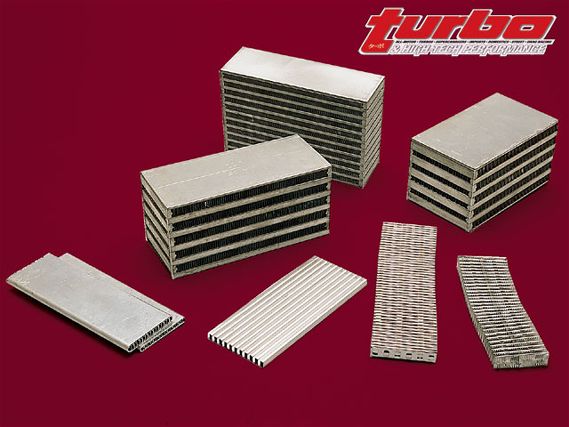 | Building blocks of intercooling.
| Building blocks of intercooling. If you think about it, trickery plays a big role in performance tuning. We fool the ECU into giving us more power with black boxes. We trick the fuel system into delivering more fuel by upping the pressure, and in the biggest con of all, we fool the atmosphere by compressing it and doubling and tripling its volume inside our engines. While forced induction is the big trick, intercooling also serves to befuddle the atmosphere in the name of power.
Intercooler Mission Statement
An intercooler's trickery centers on air density. During compression, charge air is heated and with this heat comes a decrease in air density. Density can be viewed as the amount of molecules in a given volume of air. Intercooling reverses the heating trend and endeavors to recapture some of that density.
The amount of density regained depends on the ambient temperature of the air (in air-to-air units), the efficiency of the compressor (max boost, wheel efficiency etc.) and the cooling capacity of the intercooler.
A properly sized turbo that operates at or near its peak efficiency will not heat the charge as much as a mismatched unit that has to overspeed to generate the desired boost. This extra effort results in a chopping of the air, which nets high outlet temperatures.Because of its charge chilling capabilities, the intercooler also ups the detonation threshold and, as a general rule, a good intercooler will allow you to run three to four more psi without experiencing any detonation.
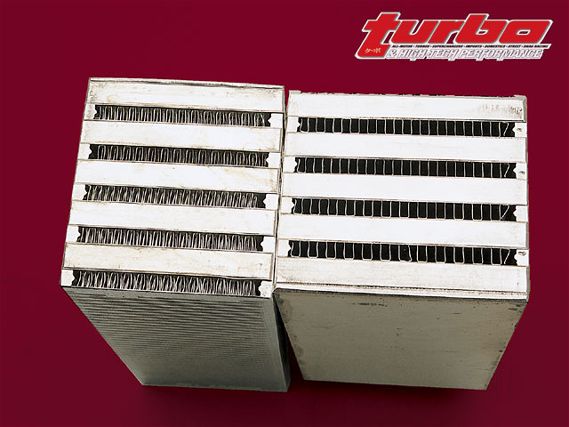 | The charge side is where boost travels to be cooled on the way to the engine. Here we see a fin comparo with the popular low-pressure drop, high-speed plain square fin (right) and an offset fin design (left). The offset fin will allow the air to travel slower through the core (more pressure drop) but the air will have more time in the core for heat exchange.
| The charge side is where boost travels to be cooled on the way to the engine. Here we see a fin comparo with the popular low-pressure drop, high-speed plain square fin (right) and an offset fin design (left). The offset fin will allow the air to travel slower through the core (more pressure drop) but the air will have more time in the core for heat exchange. Construction Techniques
Intercoolers are constructed in a number of different ways. The most popular are bar and plate and tube and fin. We cornered Johnny Wang, Spearco's product manager of heat exchangers, in the intercooler inventory room and would not let him leave until he answered some questions.
Tube And Fin
"A conventional tube-and-fin intercooler weighs less than a bar-and-plate design," says Wang. "Typical tube-and-fin units utilize extruded tubes with fins pressed into place. In order to achieve strength, a thick, extruded tube must be used.
"The tube-and-fin core is held together and its seal is created at the joints at the end of the plates, which is usually .125 inches thick. The width of the tubes is less than the width of the side plate. Space is lost where the joints for sealing are used. So a 3.5-inch core will have tubes only 2.87 inches wide."
Unable to maneuver around the machinery, Wang continued, "Also, fin design in the charge side, inside the extruded tubes, was limited by the extrusion machine, which impeded the design of charge side fin geometry to meet individual custom applications. While this design did allow varying ambient fin designs, the charge air shortcomings proved too much of a handicap.
"Tube and fin has a larger leakage rate compared to bar-and-plate cores. Furthermore, tube-and-fin cores are more susceptible to road damage from rocks and debris than bar-and-plate cores; big trouble in front-mount applications. The oval tubes are extruded from thin-wall material and any sort of extreme pressure can cause these tubes to 'balloon.' In today's high-performance industry, high boost levels are the key power."
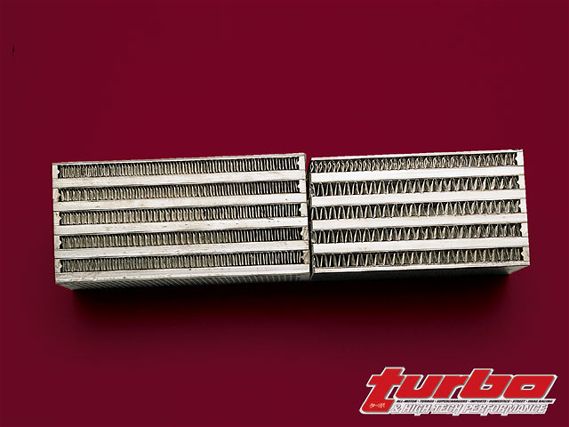 | On the ambient side, where oncoming air streams through the unit, fin design is equally important. Fin density here also impacts cooling performance but there is often the vehicle's cooling system to consider.
| On the ambient side, where oncoming air streams through the unit, fin design is equally important. Fin density here also impacts cooling performance but there is often the vehicle's cooling system to consider. Bar And Plate
Wang had a more upbeat tone when it came to bar-and-plate construction. "Spearco pioneered bar-and-plate core design. True, the bar-and-plate design is a bit heavier than tube and fin, but this is actually advantageous.
"The core acts as a heat sink. Its ability to soak up more heat is especially useful in stop-and-go traffic. It keeps the charge relatively cool, then is able to dissipate the heat once the vehicle is in motion. Tube-and-fin units can't pull this off.
"A bar-and-plate core can take the damage of front-mount life and endure high boost without flinching. Sealing is superior in bar-and-plate units because the bars and brazing sheets run the length of the unit, providing a 100-percent seal between the ambient and charge sides.
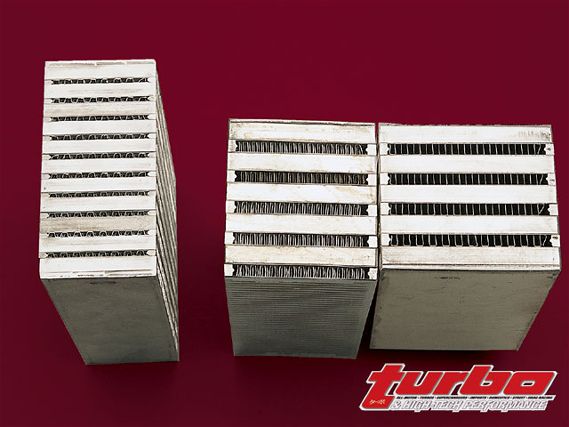 | Here we see a liquid-to-air core (left) and air-to-air units (right). A liquid cooler works opposite than a air-to-air in that the charge air is run through what would be the ambient side of a air unit and water is run through what would be the charge side.
| Here we see a liquid-to-air core (left) and air-to-air units (right). A liquid cooler works opposite than a air-to-air in that the charge air is run through what would be the ambient side of a air unit and water is run through what would be the charge side. "A key advantage of bar and plate is its extraordinary variety of fin designs on both sides of the cooler. Further, the height of the passages can be changed by using taller bars and fins, which dramatically expands the possibilities for the intercooler designer. A 3.5-inch thick core gets a 3.5-inch row of fins, not the 2.87 inches found in tube-and-fin designs.
"Also, a tube-and-fin design has a lot of room between rows where a bar-and-plate unit can get more rows into a given area with more area per passage which means more cfm and a more efficient unit. As far as big boost goes, the ability of a bar-and-plate core to handle high boost is determined by the thickness of the braze sheets, fins, side bars and top plates."
Density Dynamics
The intercooler is a crossroads of sorts. Charge air and ambient air intersect inside the unit and heat exchange occurs. The cooling properties of intercoolers are decided by its thickness (for charge air flow) and area (for cooling ambient airflow).
The thickness (and the type of fins used) dictates how quickly the charge air will move across the unit while the surface area affects how quickly ambient air will flow across the cooler. The curveball here is fin density. The number of fins per inch will dramatically impact the cooling characteristics of the unit.
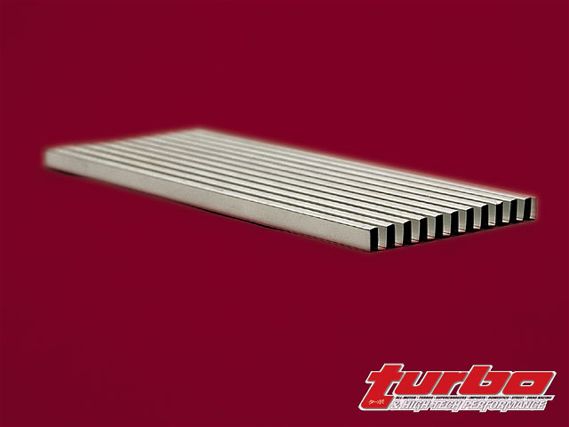 | The popular plain square fin works its magic on the charge side.
| The popular plain square fin works its magic on the charge side. "Fin combination is very crucial when designing an effective core with a very low pressure drop," says Wang. "A dense fin design offers superb heat transfer, however, this design also creates high pressure drop. Pressure drop is the amount of boost lost by the system as it pumps the charge air through the intercooler. The type of fin-plain, offset, louvered or bump-each has its own unique heat transfer characteristics.
"The key when designing any intercooler is that a median is met where the effectiveness is attained and a low-pressure drop is achieved. For example, a plain fin design offers an exceptional low pressure drop but does not provide great heat transfer compared to a louvered fin or an offset fin. The air moves quickly over/through the plain fin (low pressure drop), but is so fast it may not be in the core long enough to maximize heat transfer. Consequently, air moving through a louvered or offset fin takes longer to move through the core (more pressure drop), but it also has more time to transfer heat."
Area vs. Thickness
Wang continues, "The rule of thumb here is obvious-bigger is better. More surface area means more cooling power. However, a larger surface area is favored over a thicker core. A larger surface area provides more cooling face for the ambient air where a thicker core might be less effective. As the core gets thicker, the ambient air traveling through the core is heated by transfer and the farther through the core it travels the hotter it gets. By the time the ambient is at the back side of the unit, it's lost a good percentage of its cooling capacity. Beyond that, thick cores cause an ambient pressure drop, which means less air will make its way to the radiator causing overheating issues.
"When it comes to area, achieving the maximum height is more beneficial than widening the unit. The main reason for this is pressure drop is greater when the charge air has to travel through longer passage compared to a shorter passage. It should be noted that pressure drop through a longer-passage core can be compensated for, to a certain extent, via fin design."
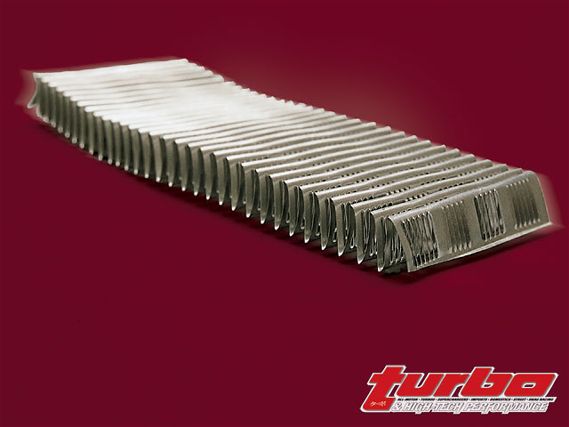 | Here we see an ambient side-louvered fin.
| Here we see an ambient side-louvered fin. Spearco produces both tube-and-fin and bar-and-plate intercoolers. With bar and plate being so superior, one has to wonder why. It's all about cost. The tube-and-fin core is much cheaper to produce and is often used in OE applications, which inherently run lower boost levels.
Spearco put a new twist on tube-and-fin cores with its extruded tube design that incorporated the fins as part of the extrusion. In this design, the overall weight was about equal to a bar-and-plate core. tube-and-fin units are cheaper to manufacture.
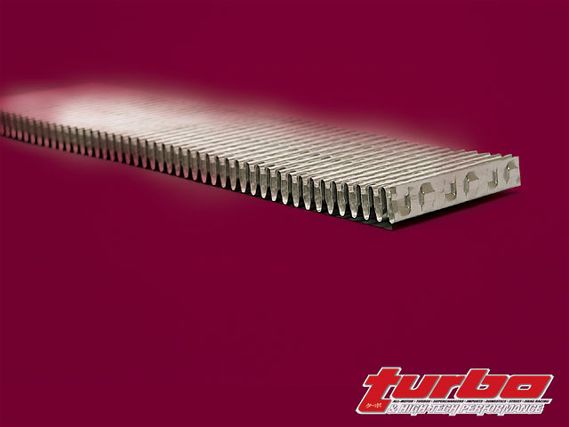 | This is an ambient side-split fin.
| This is an ambient side-split fin. Manufacturing Methods
Generally, two manufacturing methods are used to create intercoolers-vacuum furnace brazing and controlled atmospheric brazing (CAB). Vacuum furnace brazing starts with a "Lego set" of parts that are stacked and strapped together, then placed in the furnace. The headers, fins, bars and plates are aligned with a thin layer of aluminum cladding positioned in between. This clad material is designed to have a melting point slightly below that of the intercooler components. With the straps providing the proper amount of pressure, the furnace "bake-welds" the parts together in a totally inert environment (less oxidation).
CAB is very similar to vacuum furnace brazing but the component parts are dipped into a cladding solution and then assembled in the furnace. Instead of a vacuum, CAB furnaces are purged with nitrogen. Coolers made with this technique have a chalky look to them, while vacuum furnace brazing leaves more luster.
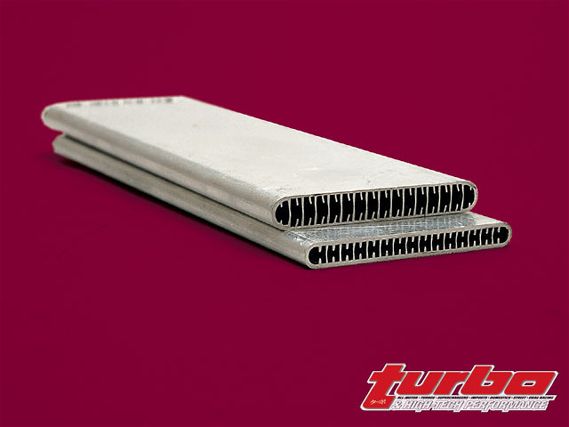 | Spearco's extruded tube charge side tube. Generally, tube and fin offers cheaper manufacturing costs, but makes compromises in durability and high-boost pressure capability.
| Spearco's extruded tube charge side tube. Generally, tube and fin offers cheaper manufacturing costs, but makes compromises in durability and high-boost pressure capability. Popular cars have intercooler kits designed especially for them, but custom applications and special circumstances may mean starting from scratch. Spearco has proprietary modeling software that will crunch the pertinent numbers to meet the cooling needs of custom applications.
Intercoolers do a lot more than look good behind a custom bumper cover. Their atmospheric trickery is the result of technical factors such as area, thickness, fin design and fin density. Controlling the flow compromises and cooling advantages of these factors will determine the ultimate driveability of your turbo system. The payoff is power.
